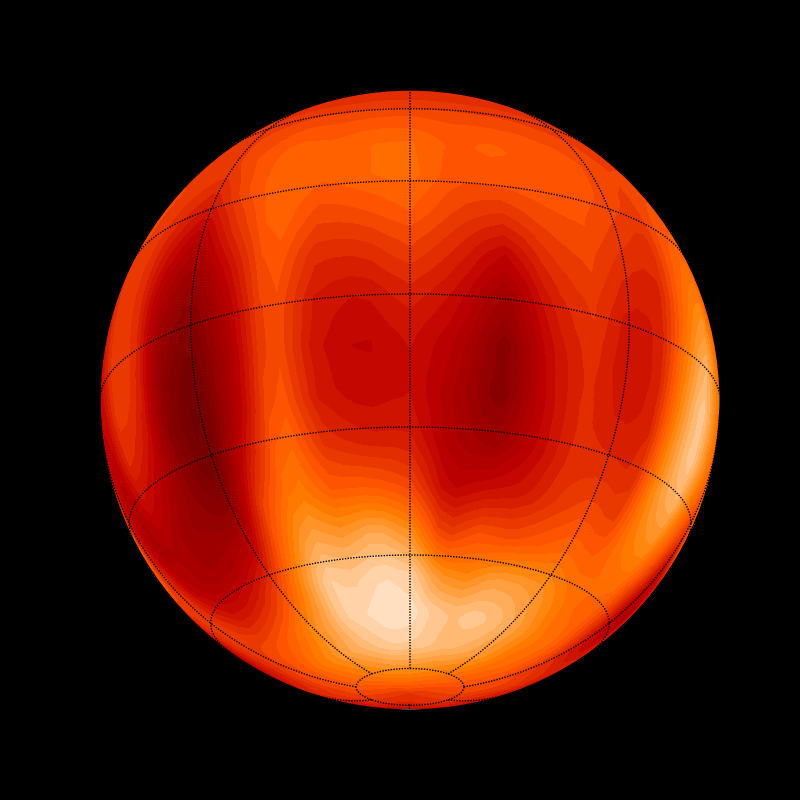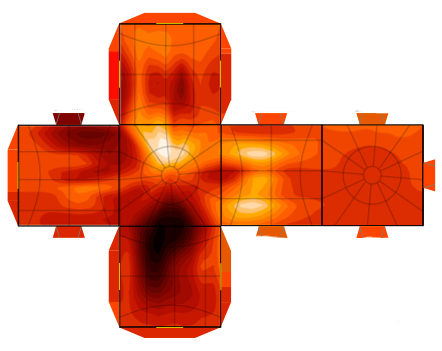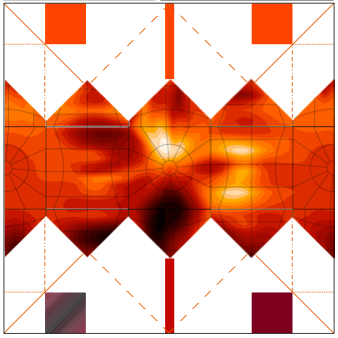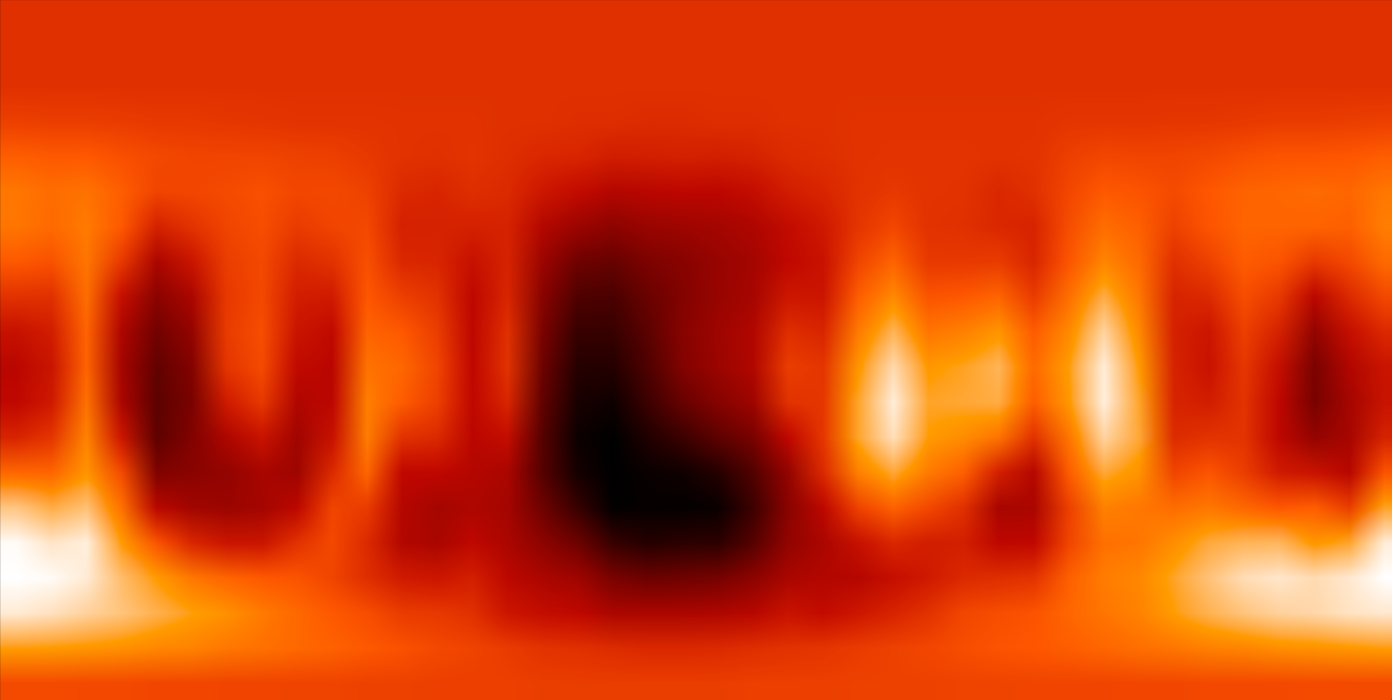MIT Kavli Institute
and MIT Department of Physics
Cambridge, MA 02139
email : iancross@mit.edu
Luhman 16

Map of Luhman 16B: the first global map of a brown dwarf. Bright regions are gaps in the clouds, where infrared light from the hotter, deeper atmosphere can escape to space.
(I. Crossfield, MPIA)
Contents Below:
- Description of Results
- Media Coverage
- Images, Movies, and Origami
- The Research Team
Description of Results:
2014 Jan: For many years, researchers have suspected that brown dwarfs -- 'failed stars,' with masses in between those of planets and stars -- have cloudy atmospheres. The temperatures of these objects -- around 1600 C -- are hot enough that silicate minerals and molten iron droplets should condense into patchy clouds. Unfortunately, because brown dwarfs are small (the size of Jupiter) and faint (because they are much cooler than stars) the properties of these clouds have only been inferred from globally averaged measurements.
In our recent paper (described here, and here), we present the first global, 2D map of the patchy clouds in the atmosphere of a brown dwarf, our neighbor Luhman 16B. Though the spatial resolution is only moderate, we still see large-scale brightness variations that we interpret as being regions of thicker (dark) and thinner (bright) clouds. In the future, we will be able to use these techniques to make the first extrasolar 'weather movies' and study the formation, evolution, and dissipation of global weather patterns beyond the Solar system for the very first time. Eventually, new tools and new, larger telescopes may even let us make these maps for giant planets in other star systems.
Read the article here at Nature, or continue below for more links and information.
(return to top of page)

Map
of Luhman
16B: Cut, cut, fold, and tuck -- ta-da, your own brown dwarf! This model requires precision cutting, but is easy to fold. Click the image (or click here) to download the PDF (1.1 MB).
(I. Crossfield, MPIA)

Map
of Luhman
16B: Cut, fold, inflate, and voila: your own brown
dwarf! This model is easy to cut out, but a
tad more complicated to fold. (see here
or
here
for instructions on folding this version.)
Click the image
(or click
here) to download the PDF (1.1 MB).
(I. Crossfield, MPIA)
Images, Movies, Etc.
Many excellent movies and images are online here, courtesy of Richard Hook and his team at the European Southern Observatory. Many of these are also available at the MPIA website, courtesy of Markus Poessel.
I also made two cut-and-fold paper models, so you can make your very own version of Luhman 16B! Click the two pictures at right to download the necessary PDF files. Of course, real brown dwarfs are spherical (like planets and stars), not cubes – but we think you'll agree that a cube is easier to cut and fold than is a sphere! For instructions on folding the origami version, see the video instructions at either WikiHow or at Arts and Hobbies.
(return to top of page)
Media Coverage
- Weather.com
- Forbes.com
- Discovery News
- Science News
- Sky and Telescope
- NBC News
- Fox News
- Daily Mail
- Space.com
- Space.com (brown dwarf overview)
- International Business Times
- Reuters
- United Press
- Business Standard
- Evening Telegraph
- GMA News
- Yahoo! News
- MSN News
- Astronomy Magazine
- Earth and Sky
- Christian Science Monitor
- Stuff.co.nz
- Voice of America
- Science Recorder
- The Space Reporter
- Science 2.0
- Headlines and Global News
- TG Daily
- Sci-News
- Physics World
- Phys.org
- Technology.org
- ABC News (Australia)
- Irish Independent
- The Scotsman
- Belfast Telegraph
- Edinburgh Herald
- Red Orbit
- Space Fellowship
- Space Exploration Network
- Space Daily
- Science Daily
- Science Newsline
- The Independent
- Tottenham News
- French Tribune
- Malaysia Sun
- Zee News (India)
- io9
- Slashdot
- IoL.com
- AllVoices.com
- Nanowerk.com
- Ciro Villa
- Big News Network
- The Daily Galaxy
- Breaking News
- Universe Today
- Frankfurter Allgemeine Zeitung
- Max-Planck Magazine (PDF) (in German)
- Der Spiegel (in German)
- Die Welt (in German)
- Max-Planck-Gesellschaft (in German)
- Welt der Physik (in German)
- Berliner Morgenpost (in German)
- AstroNews (in German)
- PressRelations (in German)
- SciNexx (in German)
- Focus (in German)
- Innovations Report (in German)
- AstroInfo (in German)
- Jura Forum (in German)
- CNRS press release (in French)
- Max-Planck-Institut press release
- European Southern Observatory press release
(return to top of page)
The Research Team
These days, few research efforts in astronomy are the work of a single person. Our work to map the clouds on Luhman 16B was no different: it was the work of a large team of people.- Dr. Beth Biller, University of Edinburgh
- Dr. Joshua E. Schlieder, Max-Planck-Institut fuer Astronomie
- Dr. Niall R. Deacon, Max-Planck-Institut fuer Astronomie
- Dr. Mickael Bonnefoy, Institut de Planetologie et d'Astrophysique de Grenoble
- Dr. Derek Homeier, Centre de Recherche Astrophysique de Lyon
- Prof. France Allard, Centre de Recherche Astrophysique de Lyon
- Dr. Esther Buenzli, Max-Planck-Institut fuer Astronomie
- Prof. Thomas Henning, Director, Max-Planck-Institut fuer Astronomie
- Dr. Wolfgang Brandner, Max-Planck-Institut fuer Astronomie
- Dr. Bertrand Goldman, Max-Planck-Institut fuer Astronomie
- Taisiya Kopytova, Max-Planck-Institut fuer Astronomie
